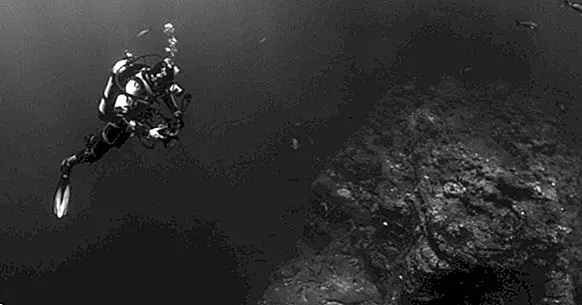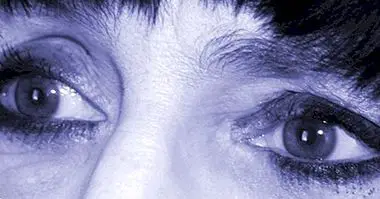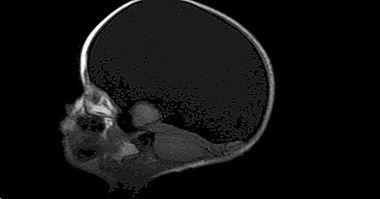Batofobia: (fear of depth): symptoms, causes, diagnosis and treatment
Are you completely unable to bathe in deep water? Do you feel great anguish only at the thought of putting your feet in a deep well? Although these reactions are usually completely normal in most cases, they perfectly describe how a person with batophobia feels.
Throughout this article we'll talk about this anxiety disorder known as batophobia . We will describe its symptoms, its causes and what are the techniques and professional interventions to treat it.
- Related article: "Types of phobias: exploring the disorders of fear"
What is batophobia?
Like the rest of phobias, batophobia is an anxiety disorder in which the person experiences an intense terror to the depths or to those situations in which you can not see the lower part of your body because of the depth or darkness.
Those spaces or situations in which the person can experience this fear can be pools, the sea, bottom of a well, etc. That is to say, spaces that convey a sense of depth .
It is necessary to specify that the fear or fear of deep spaces is completely habitual, natural and fulfills an adaptive function. So a person who suffers from this type of concern does not always have to suffer a phobia. However, in cases where the person experiences an incapacitating anxiety, which can not be controlled and which has no rational basis ; yes it would be considered as batophobia.
- Maybe you're interested: "Types of Anxiety Disorders and their characteristics"
What symptoms does the batophobia present?
As discussed above, batophobia is classified within anxiety disorders, so Exposure to the situation or phobic stimulus will trigger an extreme anxiety response .
Like the rest of the phobias, the symptoms are divided into three groups: physical symptoms, cognitive symptoms and behavioral symptoms. However, although most people experience the same symptoms, this phobia presents a great variability between people.
The main symptoms include those that we will see below.
Physical symptoms
- Acceleration of heart rhythm .
- Increase in the respiration rate.
- Hyperidrosis
- High blood pressure.
- High muscle tone.
- Nausea and vomiting .
- Stomach ache.
- Shaking chills.
- Choking sensation .
Cognitive symptoms
- Catastrophic thoughts.
- Sensation of lack of control .
Behavioral symptoms
- Escape behaviors
- Avoidance behavior
Usually, the symptoms subside once the phobic stimulus has disappeared. However, this will depend on the intensity with which the living person experiences the batophobia , since in some cases the level of anxiety increases only when thinking about these places of great depth.
What causes the batophobia?
There is no completely reliable way to determine the origin of a phobia. In most cases, a genetic predisposition linked to a traumatic experience or with a high emotional load it ends up causing a phobia to some of the elements that surrounded the experience.
For example, a person who has experienced a shipwreck or a traumatic experience in some deep place is susceptible to developing a batophobia. However, it does not always have to be this way, given that there are a lot of factors such as personality or even the environment, which facilitate the appearance of this.
How is this phobia diagnosed?
In most cases the batophobia remains undiagnosed, since the people who suffer from it usually do not usually encounter these situations, so the phobia does not interfere too much in the daily life of this.
However, in cases in which the person suffering from photophobia does have to face these situations, it is necessary to make an adequate assessment that meets the established diagnostic criteria.
Given the large number of phobias that currently exist, it has not been possible to establish a specific diagnostic protocol for each one of them. However, there are a series of common diagnostic criteria in all of these specific anxiety disorders .
When the professional is ready to evaluate the patient must take into account the following aspects of the diagnosis:
- Feeling of fear and response of immediate anxiety before the appearance of the phobic stimulus. In this case the depths.
- The person carries out avoidance or escape behaviors when faced with the stimulus or dreaded situation.
- The experimentation of fear is valued as disproportionate taking into account the real danger.
- The fear appears for more than six months each time the person is exposed.
- The symptoms and consequences of these generate clinically significant discomfort.
- The phobia and its symptoms interfere with the patient's life.
- Symptoms can not be better explained by any other disease or mental disorder.
Is there a treatment?
With an adequate diagnosis and treatment, both the batophobia and any other type of anxiety disorder can remit almost completely.
Usually, the treatment of choice to help people with these types of disorders is based on intervention through psychotherapy, always by the hand of a professional in psychology .
Within these psychotherapies, the cognitive behavioral treatment is the one that has stood out for presenting greater efficiency and speed at the time of the symptoms remit. However, there is a large amount of interventions and therapies that, performed correctly and always by the hand of an expert , can also offer satisfactory results.
Within the treatment with cognitive behavioral therapy the following actions can be carried out.
1. Live exhibition
The avoidance carried out by people with batophobia, or with any type of anxiety disorder, is the first reason why it is maintained over time. Thus, through live exposure the patient is confronted with the dreaded situation or to the phobic stimulus.
However, it is necessary that this exhibition is always conducted by a professional.
- Related article: "Intervention in phobias: the technique of the exhibition"
2. Systematic desensitization
When the anxiety response is so extreme that a live exposure can not be made, an intervention will be carried out by systematic desensitization. With this technique that the patient is gradually exposed to the phobic stimulus .
3. Relaxation techniques
It is essential that both intervention by live exposure and systematic desensitization be accompanied by a training in relaxation techniques that reduces the patient's alertness and facilitate your approach to the feared stimulus.
- Related article: "6 easy relaxation techniques to combat stress"
4. Cognitive therapy
Since an essential component of phobias are the distorted thoughts that exist about the phobic stimulus, the use of cognitive therapy that helps eliminate them is essential .



















